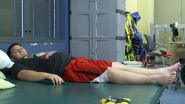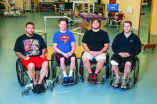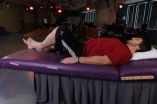(Press-News.org) Four people with paraplegia are able to voluntarily move previously paralyzed muscles as a result of a novel therapy that involves electrical stimulation of the spinal cord, according to a study funded in part by the National Institutes of Health and the Christopher & Dana Reeve Foundation. The participants, each of whom had been paralyzed for more than two years, were able to voluntarily flex their toes, ankles, and knees while the stimulator was active, and the movements were enhanced over time when combined with physical rehabilitation. Researchers involved in the study say the therapy has the potential to change the prognosis of people with paralysis even years after injury.
"When we first learned that a patient had regained voluntary control as a result of spinal stimulation, we were cautiously optimistic," said Roderic Pettigrew, Ph.D., M.D., director of the National Institute of Biomedical Imaging and Bioengineering (NIBIB) at NIH, which provided support for the study. "Now that spinal stimulation has been successful in 4 out of 4 patients, there is evidence to suggest that a large cohort of individuals, previously with little realistic hope of any meaningful recovery from spinal cord injury, may benefit from this intervention."
One of the most impressive and unexpected findings of the study is that two of the patients who benefited from the spinal stimulation had complete motor and sensory paralysis. In these patients, the pathway that sends information about sensation from the legs to the brain is disrupted, in addition to the pathway that sends information from the brain to the legs in order to control movement. The researchers were surprised by the outcome; they had assumed that at least some of the sensory pathway needed to be intact for the therapy to be effective.
The study is the continuation of a groundbreaking pilot trial initiated in 2009 to determine whether spinal stimulation, in conjunction with daily training on a treadmill, could help patients with paralysis regain some ability to move. In that trial, Rob Summers, a young man paralyzed below his chest, had a 16-electrode array implanted on his spinal cord. He then underwent daily training in which he was suspended in a harness over a treadmill while a team of researchers supported his legs, helping him to either stand or walk. At the same time, the array delivered electrical pulses to his spinal cord just below his injury.
According to the researchers, the goal of the stimulation was to increase the sensitivity of local circuits within the spinal cord that carry out basic motor functions without input from the brain—such as the knee jerk that occurs after stepping on a tack, or even more complex patterned movements like stepping. While not strong enough to directly induce muscle activation by itself, the researchers believed the stimulation could lead to movement when combined with sensory input from stepping on a treadmill.
With his stimulator active, Summers was able to gradually bear his own weight and could eventually stand without assistance from physical therapists for up to four minutes. Surprisingly, seven months into the trial, Summers also discovered that he had regained some voluntary control of his legs. The researchers were amazed by this latter outcome, as intentional movement requires information to travel from the brain down to the lower spinal cord, a path that had been rendered nonfunctional by his injury. Other impairments caused by Summers' injury also began to improve over time, in the absence of stimulation, such as blood pressure control, body temperature regulation, bladder control, and sexual function.
Now, in this follow-up study, Claudia Angeli, Ph.D., assistant professor at the University of Louisville's Kentucky Spinal Cord Injury Research Center and her research colleagues report that three additional patients with paralysis have recovered voluntary muscle control following electrical stimulation of the spine. Their report, which also includes results from new tests conducted on Summers, was published in the April 8 online issue of Brain.
The three patients in the new study include two with complete motor and sensory paralysis, and one, similar to Summers, with complete motor paralysis but some ability to experience sensation below his injury. Within just a few days of the start of stimulation, all three patients regained some voluntary control of previously paralyzed muscles.
The first person they implanted after Summers was unable to move or experience any sensation below his injury and was initially meant to be their baseline patient. "What was astounding about him was that not only was there voluntary movement, but we saw it in the first week of stimulation. We then saw it in the next two patients as well," said Susan Harkema, Ph.D., the director of rehabilitation research at the Kentucky Spinal Cord Injury Research Center at the University of Louisville, and a researcher in the study.
The researchers point to the speed at which each subject recovered voluntary movement as evidence that there may be dormant connections that exist in patients with complete motor paralysis. "Rather than there being a complete separation of the upper and lower regions relative to the injury, it's possible that there is some contact, but that these connections are not functional," said V. Reggie Edgerton, Ph.D., a UCLA distinguished professor of integrative biology and physiology, and the researcher responsible for developing the novel approach to rehabilitation. "The spinal stimulation could be reawakening these connections."
An important aspect of the new study involved assessing the ability of each patient to modulate his movements in response to auditory and visual cues. "We hoped to determine if they could voluntarily move in the presence of stimulation, and also how controlled they could be about their movements," said Angeli.
All participants, including Summers, were able to synchronize leg, ankle, and toe movements in unison with the rise and fall of a wave displayed on a computer screen, and three out of the four were able to change the force at which they flexed their leg, depending on the intensity of three different auditory cues.
"The fact that the brain is able to take advantage of the few connections that may be remaining, and then process this complicated visual, auditory, and perceptual information, is pretty amazing. It tells us that the information from the brain is getting to the right place in the spinal cord, so that the person can control, with fairly impressive accuracy, the nature of the movement," said Edgerton.
The same tests were also administered following several months of spinal stimulation applied in conjunction with locomotor training. During this time, patients also carried out home-based training, which consisted of hour-long stimulation while practicing intentional movements lying down. At the end of the training, some subjects were able to execute voluntary movements with greater force and with reduced stimulation, while others experienced enhanced movement accuracy. Harkema says it's unclear whether the improvement was a result of the training or due to the cumulative effects of stimulation over time. They plan to test this distinction in their next study.
"With this study the investigators show that their findings about a motor complete patient regaining movement, reported three years ago in The Lancet, were not an anomaly," said Susan Howley, executive vice president for research at the Christopher & Dana Reeve Foundation, Short Hills, N.J., which provides patient advocacy and funding for spinal cord injury research. "The implications of this study for the entire field are quite profound and we can now envision a day where epidural stimulation might be part of a cocktail of therapies used to treat paralysis."
With support from NIBIB, Edgerton, along with collaborators Joel Burdick and Y.C. Tai, professors of mechanical and electrical engineering and bioengineering at Caltech, are also working to develop a new high-density, 27-electrode array in rats to determine if it can provide finer, more robust control of locomotion.
"The technology we used in these four individuals was initially designed for the suppression of back pain, and our animal experiments have told us that we can do much better," said Edgerton. "For a given type of movement, we want to be able to select exactly where and how to stimulate the spinal cord. We just don't have that flexibility in the current technology."
Edgerton is also working with various collaborators on NIBIB-funded projects to explore whether epidural stimulation can be used to help patients with paralysis of the upper limbs. They are also developing a technology that can deliver spinal stimulation through the skin (transcutaneously), which would bypass the need for surgical implantation.
VIDEO:
For the first segment of Kent and voluntary training:
Kent Stephenson does voluntary training with stimulation at the Human Locomotion Research Center laboratory, a part of the University of Louisville's Kentucky...
Click here for more information.
Though there is much work to be done, Harkema believes the results from this newest study already provide enough evidence to challenge currently held beliefs about the prognosis of patients with severe spinal cord injuries.
"Right now, the clinical perspective for individuals with complete motor paralysis is that there is nothing we can do," said Harkema "I think we need to rethink that. In our study, we demonstrated potential beyond any expectation. We need to relook at what the perceived potential is for this group of individuals."
"This is a wake-up call for how we see motor complete spinal cord injury," said Edgerton. "We don't have to necessarily rely on regrowth of nerves in order to regain function. The fact that we've observed this in all four patients suggests that this is actually a common phenomenon in those with complete paralysis."
INFORMATION:
This work was supported by the National Institute of Biomedical Imaging and Bioengineering and the National Institute of General Medical Sciences at NIH under the award numbers EB007615 and GM103507, the Christopher & Dana Reeve Foundation, the Kessler Foundation, the Leona M. and Harry B. Helmsley Charitable Trust, University of Louisville Foundation, and Jewish Hospital and St. Mary's Foundation, Frazier Rehab Institute and University Hospital.
NIBIB's mission is to improve health by leading the development and accelerating the application of biomedical technologies. The Institute is committed to integrating the physical and engineering sciences with the life sciences to advance basic research and medical care. NIBIB supports emerging technology research and development within its internal laboratories and through grants, collaborations, and training. More information is available at the NIBIB website: http://www.nibib.nih.gov.
NIGMS' mission is to support basic research to increase our understanding of life processes and lay the foundation for advances in disease diagnosis, treatment and prevention. For more information on the institute's research and training programs, see http://www.nigms.nih.gov.
The National Institutes of Health, the nation's medical research agency, includes 27 Institutes and Centers and is a component of the U.S. Department of Health and Human Services. NIH is the primary federal agency conducting and supporting basic, clinical, and translational medical research, and is investigating the causes, treatments, and cures for both common and rare diseases. For more information about NIH and its programs, visit http://www.nih.gov.
Spinal stimulation helps 4 patients with paraplegia regain voluntary movement
Groundbreaking results bring new hope for those with spinal cord injury -- NIH study
2014-04-08
ELSE PRESS RELEASES FROM THIS DATE:
Snowstorms and power outages present elevated risk for carbon monoxide poisoning
2014-04-08
Ann Arbor, MI, April 8, 2014 – While preventable, carbon monoxide poisoning is a serious and sometimes fatal condition. Large weather events, such as snowstorms and heavy storms that cause power outages, can lead to an increase in the number of reported carbon monoxide exposures. Researchers from Hartford Hospital in Hartford, Connecticut explored the link between these major storms and the rise in carbon monoxide exposure cases. They found that portable generators were the most common source of carbon monoxide exposure after storms which resulted in power losses; car exhaust ...
Antimicrobial from soaps promotes bacteria buildup in human noses
2014-04-08
An antimicrobial agent found in common household soaps, shampoos and toothpastes may be finding its way inside human noses where it promotes the colonization of Staphylococcus aureus bacteria and could predispose some people to infection. Researchers at the University of Michigan report their findings this week in a study published in mBio®, the online open-access journal of the American Society for Microbiology.
Triclosan, a man-made compound used in a range of antibacterial personal care products such as soaps, toothpastes, kitchen surfaces, clothes and medical equipment, ...
Breakthrough therapy allows 4 paraplegic men to voluntarily move their legs
2014-04-08
Four young men who have been paralyzed for years achieved groundbreaking progress — moving their legs — as a result of epidural electrical stimulation of the spinal cord, an international team of life scientists reports today in the medical journal Brain.
The study, conducted by researchers from the University of Louisville, UCLA and the Pavlov Institute of Physiology, was funded in part by the Christopher and Dana Reeve Foundation and the National Institutes of Health.
All four participants were classified as suffering from chronic, motor complete spinal cord injuries ...
From athletes to couch potatoes: Humans through 6,000 years of farming
2014-04-08
Human bones are remarkably plastic and respond surprisingly quickly to change. Put under stress through physical exertion – such as long-distance walking or running – they gain in strength as the fibres are added or redistributed according to where strains are highest. The ability of bone to adapt to loading is shown by analysis of the skeletons of modern athletes, whose bones show remarkably rapid adaptation to both the intensity and direction of strains.
Because the structure of human bones can inform us about the lifestyles of the individuals they belong to, they can ...
New ammunition in the fight against type 2 diabetes
2014-04-08
Gastric banding can play a vital role in the treatment of type 2 diabetes in people who are overweight and not obese, according to new research.
The Monash University study, led by Emeritus Professor Paul O'Brien and Dr John Wentworth from the Centre for Obesity Research and Education (CORE), has determined that weight loss surgery (gastric banding) for overweight people with diabetes had a profound impact on the illness.
The research has been released today in the prestigious medical journal The Lancet Diabetes and Endocrinology.
"This is the first randomised controlled ...
Annals of Internal Medicine tip sheet for April 8, 2014
2014-04-08
1. Daily low-dose aspirin may protect against preeclampsia complications
Daily low-dose aspirin beginning as early as the second trimester of pregnancy may prevent complications from preeclampsia, according to an article being published in Annals of Internal Medicine. Preeclampsia is a condition characterized by high blood pressure and proteinuria during the second half of pregnancy. Poor perinatal health outcomes are associated with preeclampsia, primarily due to increased risk for intrauterine growth restriction (IUGR) or medically initiated preterm delivery. Preeclampsia ...
Running geese give insight into low oxygen tolerance
2014-04-08
A new study into how the world's highest flying bird, the bar-headed goose, is able to survive at extreme altitudes may have future implications for low oxygen medical conditions in humans.
An international team of scientists recently tracked the bar-headed goose while it migrated across the Himalayas. Now they have shown how these birds are able to tolerate running at top speed while breathing only 7% oxygen.
Exercising at high altitude is a massive challenge since at the top of the highest mountains the air is only made up of 7% oxygen, compared with 21% at sea level. ...
Faster eye responses in Chinese people not down to culture
2014-04-08
New research from University of Liverpool scientists has cast doubt on the theory that neurological behaviour is a product of culture in people of Chinese origin.
Scientists tested three groups – students from mainland China, British people with Chinese parents and white British people – to see how quickly their eyes reacted to dots appearing in the periphery of their vision.
These rapid eye movements, known as saccades, were timed in all of the participants to see which of them were capable of making high numbers of express saccades – particularly fast responses which ...
For good and ill, immune response to cancer cuts both ways
2014-04-07
The difference between an immune response that kills cancer cells and one that conversely stimulates tumor growth can be as narrow as a "double-edged sword," report researchers at the University of California, San Diego School of Medicine in the April 7, 2014 online issue of the Proceedings of the National Academy of Sciences.
"We have found that the intensity difference between an immune response that stimulates cancer and one that kills it may not be very much," said principal investigator Ajit Varki, MD, Distinguished Professor of Medicine and Cellular and Molecular ...
Genetic predisposition to liking amphetamine reduces risk of schizophrenia and ADHD
2014-04-07
Genetic variants associated with enjoying the effects of d-amphetamine—the active ingredient in Adderall—are also associated with a reduced risk for developing schizophrenia and attention deficit hyperactivity disorder (ADHD), report scientists from the University of Chicago in the Proceedings of the National Academy of Sciences on April 7. The results support a long-standing hypothesis that dopamine, the neurotransmitter connected with the euphoric effects of amphetamine, is related to schizophrenia and ADHD.
"Some of the variants that make you like amphetamine also ...
LAST 30 PRESS RELEASES:
Heart-brain connection: international study reveals the role of the vagus nerve in keeping the heart young
Researchers identify Rb1 as a predictive biomarker for a new therapeutic strategy in some breast cancers
Survey reveals ethical gaps slowing AI adoption in pediatric surgery
Stimulant ADHD medications work differently than thought
AI overestimates how smart people are, according to HSE economists
HSE researchers create genome-wide map of quadruplexes
Scientists boost cell "powerhouses" to burn more calories
Automatic label checking: The missing step in making reliable medical AI
Low daily alcohol intake linked to 50% heightened mouth cancer risk in India
American Meteorological Society announces Rick Spinrad as 2026 President-Elect
Biomass-based carbon capture spotlighted in newly released global climate webinar recording
Illuminating invisible nano pollutants: advanced bioimaging tracks the full journey of emerging nanoscale contaminants in living systems
How does age affect recovery from spinal cord injury?
Novel AI tool offers prognosis for patients with head and neck cancer
Fathers’ microplastic exposure tied to their children’s metabolic problems
Research validates laboratory model for studying high-grade serous ovarian cancer
SIR 2026 delivers transformative breakthroughs in minimally invasive medicine to improve patient care
Stem Cell Reports most downloaded papers of 2025 highlight the breadth and impact of stem cell research
Oxford-led study estimates NHS spends around 3% of its primary and secondary care budget on the health impacts of heat and cold in England
A researcher’s long quest leads to a smart composite breakthrough
Urban wild bees act as “microbial sensors” of city health.
New study finds where you live affects recovery after a hip fracture
Forecasting the impact of fully automated vehicle adoption on US road traffic injuries
Alcohol-related hospitalizations from 2016 to 2022
Semaglutide and hospitalizations in patients with obesity and established cardiovascular disease
Researchers ‘listen in’ to embryo-mother interactions during implantation using a culture system replicating the womb lining
How changing your diet could help save the world
How to make AI truly scalable and reliable for real-time traffic assignment?
Beyond fragmented markets: A new framework for efficient and stable ride-pooling
Can shape priors make road perception more reliable for autonomous driving?
[Press-News.org] Spinal stimulation helps 4 patients with paraplegia regain voluntary movementGroundbreaking results bring new hope for those with spinal cord injury -- NIH study



